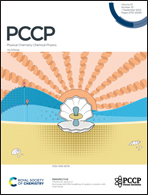Computational investigation of photoswitch conjugates for molecular solar energy storage†
Abstract
Solar energy conversion and storage are vital for combating climate change. Molecular solar thermal systems offer a promising solution, where energy is stored in molecular compounds. This study investigates dyad molecular photoswitches by combining bicyclooctadiene/tetracyclooctane and dihydroazulene/vinylheptafulvene systems with phenyl and cyano groups. Density functional theory calculations were employed to determine molecular properties and consider solvation effects in toluene and dichloromethane. The results show that the combined systems have a predicted storage energy of up to 206.14 kJ mol−1 and an absorption peak at 390.26 nm with appreciable intensity. These dyad photoswitches exhibit favorable properties for molecular solar thermal storage and other applications. A comparison with individual photoswitches reveals advantages and disadvantages. The most effective conjugate has a slightly lower storage density than an equal mixture of individual systems, but it demonstrates better absorption characteristics, with improved overlap with the solar spectrum and higher absorption intensity. These findings contribute to the understanding of dyad molecular photoswitches, showcasing their potential for advanced energy storage and conversion technologies.



 Please wait while we load your content...
Please wait while we load your content...